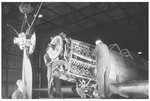wuzak
Captain
I have received an installation drawing of the Vulture II/IV, complete with a number of dimensions.
Scaling from the drawing I found that the Vulture would fit inside a 48" circle - some 4-5" smaller in diameter than a P&W R-2800/R-4360 and 8-9" smaller than a Wright R-1820/R-2600/R-3350 or a Bristol Hercules/Centaurus.
So the Vulture would easily fit up to a bulkhead designed for one of those radials, with space to spare. The downside is that it is longer than all, except the R-4360.
Feeding the exhausts back to the twin turbos, as in the proposed British B-29 version, may be an interesting proposition, as it would have to negotiate the engine mountings and the two speed drive wheel case. Perhaps a single speed drive would provide less impediment to the routing of exhausts.
The drawing also seems to indicate that the Vulture had one piece block/heads - like Merlins post Ramp Head to the changeover to two piece block/heads around 1942.
Scaling from the drawing I found that the Vulture would fit inside a 48" circle - some 4-5" smaller in diameter than a P&W R-2800/R-4360 and 8-9" smaller than a Wright R-1820/R-2600/R-3350 or a Bristol Hercules/Centaurus.
So the Vulture would easily fit up to a bulkhead designed for one of those radials, with space to spare. The downside is that it is longer than all, except the R-4360.
Feeding the exhausts back to the twin turbos, as in the proposed British B-29 version, may be an interesting proposition, as it would have to negotiate the engine mountings and the two speed drive wheel case. Perhaps a single speed drive would provide less impediment to the routing of exhausts.
The drawing also seems to indicate that the Vulture had one piece block/heads - like Merlins post Ramp Head to the changeover to two piece block/heads around 1942.

